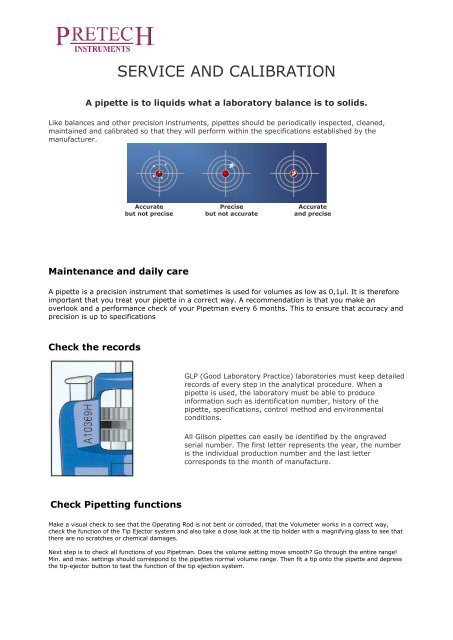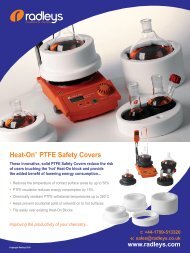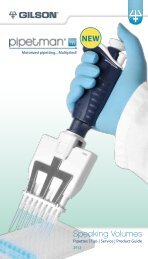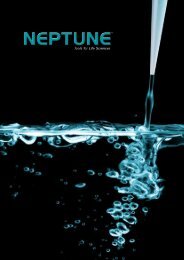SERVICE AND CALIBRATION - Pretech Instruments
SERVICE AND CALIBRATION - Pretech Instruments
SERVICE AND CALIBRATION - Pretech Instruments
Create successful ePaper yourself
Turn your PDF publications into a flip-book with our unique Google optimized e-Paper software.
<strong>SERVICE</strong> <strong>AND</strong> <strong>CALIBRATION</strong><br />
A pipette is to liquids what a laboratory balance is to solids.<br />
Like balances and other precision instruments, pipettes should be periodically inspected, cleaned,<br />
maintained and calibrated so that they will perform within the specifications established by the<br />
manufacturer.<br />
Accurate<br />
but not precise<br />
Precise<br />
but not accurate<br />
Accurate<br />
and precise<br />
Maintenance and daily care<br />
A pipette is a precision instrument that sometimes is used for volumes as low as 0,1µl. It is therefore<br />
important that you treat your pipette in a correct way. A recommendation is that you make an<br />
overlook and a performance check of your Pipetman every 6 months. This to ensure that accuracy and<br />
precision is up to specifications<br />
Check the records<br />
GLP (Good Laboratory Practice) laboratories must keep detailed<br />
records of every step in the analytical procedure. When a<br />
pipette is used, the laboratory must be able to produce<br />
information such as identification number, history of the<br />
pipette, specifications, control method and environmental<br />
conditions.<br />
All Gilson pipettes can easily be identified by the engraved<br />
serial number. The first letter represents the year, the number<br />
is the individual production number and the last letter<br />
corresponds to the month of manufacture.<br />
Check Pipetting functions<br />
Make a visual check to see that the Operating Rod is not bent or corroded, that the Volumeter works in a correct way,<br />
check the function of the Tip Ejector system and also take a close look at the tip holder with a magnifying glass to see that<br />
there are no scratches or chemical damages.<br />
Next step is to check all functions of you Pipetman. Does the volume setting move smooth? Go through the entire range!<br />
Min. and max. settings should correspond to the pipettes normal volume range. Then fit a tip onto the pipette and depress<br />
the tip-ejector button to test the function of the tip ejection system.
Leak test<br />
To make sure that your Pipetman is in good condition it is recommended to do a<br />
leak test. Fit a Gilson tip and set the volume at maximum. Aspirate water and<br />
maintain liquid 20 seconds in the tip. Observe if a drop or leak appears at the<br />
orifice of the tip. For P2-P200 re-immerse in the test liquid. The fluid level should<br />
not descend. This test is recommended to be performed daily. If there is a leak you<br />
need to exchange the O-ring and Teflon Seal and perhaps the Tip Holder. This you can do yourself by<br />
following the instructions under Disassemble below.<br />
Disassemble the pipette<br />
If the pipette has a leak or does not work properly you might need to disassemble it. Simply pull off<br />
the tip ejector. Then unscrew the connecting nut and separate the handle from the bottom part.<br />
Remove the piston from the tip holder. Now check the piston. Is it scratched or corroded? Also check<br />
the seal and o-ring. Are they damaged or maybe worn out? Same thing with the tip holder. Check the<br />
lower end for scratches and the internal for dirt. Change all parts that is damaged or worn out. If the<br />
piston is changed, the pipette needs recalibration. When you reassemble the pipette make sure to<br />
respect the correct order of the parts. The piston seal should always be positioned before the o-ring.<br />
Return to <strong>Pretech</strong> for service<br />
<strong>Pretech</strong> has a fully equipped calibration laboratory with balances controlled by SWEDAC. All personnel<br />
handling your pipettes are trained by Gilson. The environmental parameters such as temperature,<br />
humidity and air pressure is logged 24 hours a day. These values are used to estimate evaporation<br />
and to convert readings as weight (mg) to volume (µl).<br />
Standard service and repair or... cost saving = Service contract<br />
We perform full service, calibration and adjustment on all Gilson pipettes as described later. We also<br />
offer a control of your pipette. This means that we verify the status of the pipette and if it corresponds<br />
to Gilson specifications or not.<br />
For customer that want to have regular service, we recommend to sign up for a service contract. This<br />
is a convenient way of having problem-free pipetting year after year. All pipettes calibrated under a<br />
contract are washed and decontaminated. New tip holder, piston seal and O-ring are included in the<br />
price. Signing up for a contract saves you 25% compared with regular service. Contact us and we will<br />
tell you more about the advantages of signing up for a contract for Gilson pipettes. We will return your<br />
pipettes with a minimum of delay. From door to door normal delivery time is not more than one week.<br />
Standard service<br />
You can at any time send us your pipettes for service and calibration. You can send them one by one<br />
or a few together as it suits you. Our personnel will take care of them in order of arrival and perform<br />
the same service as described above.<br />
Certificate of calibration<br />
With each serviced and calibrated pipette follows a calibration certificate that is set up according to<br />
GLP. All measurements, temperature, humidity and air pressure is displayed. For historical records<br />
earlier calibration values are also written on the certificate.
Decontamination and repair<br />
All pipettes are disassembled, washed, decontaminated and then dried in an oven for 4 hours. After<br />
that the pipettes are left overnight at room temperature for stabilisation. We make control of all<br />
mechanical parts and change them if needed. Tip holder, piston seal and o-ring are always exchanged.<br />
All mechanical functions such as piston movement, tip ejector mechanism and counter are controlled.<br />
After assembly the pipettes are placed in a carrousel stand in the calibration room and will rest for at<br />
least 30 minutes. This means that the pipette are mechanically stabilized before the actual calibration<br />
will begin.<br />
Calibration<br />
According to Gilson calibration procedure all pipettes are checked by five measurements on low (min.)<br />
and high (max.) volume. If the pipette is outside of Gilson specifications, it needs to be re-calibrated<br />
by mechanical adjustment. Five new measurements are then performed again. This to verify that the<br />
pipette now corresponds to Gilson specifications.<br />
Next step in the procedure is to verify the pipettes maximum volume.<br />
If the pipette still falls outside the allowed tolerance, it needs to be re-calibrated and adjusted again.<br />
This procedure is repeated until the pipette corresponds to Gilson specification.<br />
Perform service by yourself<br />
If you want to do more than change tip holder and seals yourself <strong>Pretech</strong> offer the following tools and<br />
services:<br />
Calibration tool<br />
Training at customers site<br />
Swedish pipetting guide with drawings<br />
Gilson guide to pipetting<br />
All spare parts in stock for fast delivery<br />
PRETECH <strong>Instruments</strong><br />
Mikael Hollmark<br />
Email: mikael.hollmark@pretech.nu<br />
Tel: 08 - 92 00 09
















